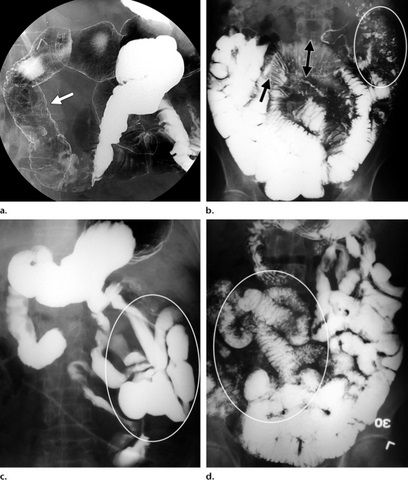CT Bests Barium in Adult Celiac Disease Diagnosis
Improvements in computed tomography (CT) resolution of the small bowel, colon, and mesenteric lymph nodes have pushed CT scans ahead of traditional barium examinations in the diagnosis of celiac disease, according to a new study in the journal RadioGraphics.
Improvements in computed tomography (CT) resolution of the small bowel, colon, and mesenteric lymph nodes have pushed CT scans ahead of traditional barium examinations in the diagnosis of celiac disease, according to a new study in the journal RadioGraphics.
The study, led by Francis Scholz, MD, a radiologist in the Lahey Clinic in Burlington, Mass., reviewed CT findings from more than 200 cases of celiac disease from 1996 to 2009. The CT scans highlighted abnormal structural changes known to result from the disease, and in more detail than possible with a traditional barium examination, Scholz and colleagues said.

Findings of malabsorption at barium examination. (a) Image shows duodenitis with nodularity in a fold-free duodenum (arrow). (b) Image shows flocculation (within oval at upper right), dilution (single arrow), and dilatation (double arrow). (c) Image shows moulage (within oval), which is a featureless bald appearance of the jejunum caused by atrophy of folds and wall edema. (d) Image shows reversal of the fold pattern (within oval), with more prominent folds in the ileum than in the jejunum. (courtesy RadioGraphics)
Celiac disease is a chronic autoimmune disorder induced in genetically susceptible individuals after ingestion of gluten proteins, which are found in wheat, rye, barley, and certain other grains.
About one in 200 Americans suffer from celiac disease, but less than 10 percent of cases are currently diagnosed, the authors said. Diagnosis of celiac disease takes an average of more than 10 years from the onset of symptoms.
The small bowel mucosa is primarily affected, resulting in progressive degrees of villus inflam¬mation and destruction with resulting induction of crypt hyperplasia, the authors said. The destruction be¬gins in the duodenum and over time progresses distally to the ileum. Loss of villi, which absorb fluid, and hypertrophy of crypts, which produce fluid, result in chronic fluid excess in the small bowel lumen. Chronic excess fluid and its effects on bowel wall structure and tone create the small bowel malabsorption pattern (MABP), which was described long ago in barium studies of patients with celiac disease, the authors said.
While celiac disease will remain difficult for radiologists to diagnose, the authors said a pattern of small bowel and colonic findings with mesenteric lymph node prominence at CT should suggest celiac disease. A simple blood test costing less than $100 usually allows confirmation of the diagnosis, they added.
Could Lymph Node Distribution Patterns on CT Improve Staging for Colon Cancer?
April 11th 2025For patients with microsatellite instability-high colon cancer, distribution-based clinical lymph node staging (dCN) with computed tomography (CT) offered nearly double the accuracy rate of clinical lymph node staging in a recent study.
The Reading Room Podcast: Current Perspectives on the Updated Appropriate Use Criteria for Brain PET
March 18th 2025In a new podcast, Satoshi Minoshima, M.D., Ph.D., and James Williams, Ph.D., share their insights on the recently updated appropriate use criteria for amyloid PET and tau PET in patients with mild cognitive impairment.
Could Ultrafast MRI Enhance Detection of Malignant Foci for Breast Cancer?
April 10th 2025In a new study involving over 120 women, nearly two-thirds of whom had a family history of breast cancer, ultrafast MRI findings revealed a 5 percent increase in malignancy risk for each second increase in the difference between lesion and background parenchymal enhancement (BPE) time to enhancement (TTE).
AMA Approves Category III CPT Codes for AI-Enabled Perivascular Fat Analysis from CT Scans
April 9th 2025Going into effect in 2026, the new CPT codes may facilitate increased adoption of the CaRi-Heart software for detecting coronary inflammation from computed tomography scans pending FDA clearance of the technology.